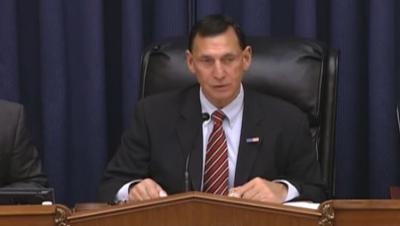Says After 30 Years, System Is Nowhere Near Where It Needs To Be
House Transportation Committee Chairman Bill Shuster (R-PA) told a representative of the Department of Transportation and others at a Tuesday hearing that the FAA's ATC modernization efforts are lagging despite millions of dollars spent by the agency.

The remarks came at Tuesday's hearing of the Aviation Subcommittee. "The bottom line is, after three decades of various modernization attempts and billions of taxpayer dollars spent, we’re nowhere near where we need to be," Shuster (pictured) said in his prepared remarks. "While the FAA has spent approximately $6 billion to date on NextGen, passengers, shippers, and aircraft operators have seen few benefits. In fact, ATC delays are up at 13 of our 20 largest airports, and domestic flights take longer now than they did in 1977. Delays ripple throughout the system and cost tens of billions of dollars every year.
"As our system approaches one billion passengers per year, under these circumstances, two things will happen. One: every day at the airport is going to seem like the day before Thanksgiving. And two: we will lose our lead in aviation as other nations catch up and surpass us. Neither outcome is acceptable."
Shuster said that his comments were not an indictment of FAA's leadership team or the controllers themselves. "The underlying problem is that air traffic control is a high-tech service. The customers are companies and individuals who pay good money to a service provider that is not a business, but a vast government bureaucracy. As a government agency, the FAA is simply not set up to determine risks, pursue the most cost-efficient investments, manage people to produce results, reward excellence, or punish incompetence like a normal business. In the same amount of time FAA has been working on NextGen, Verizon has upgraded its wireless network four times."

Subcommittee chair Frank LoBiondo (R-NJ) (pictured) said "distressing realities" may be the impetus needed to drive change. "Three years of federal budget disputes have included the FAA’s decision in April 2013 to furlough 10 percent of its air traffic controller workforce and nearly close 149 contract towers to meet sequester-driven budgetary cuts; the partial shutdown of the FAA in August 2011; and schedule delays and cost overruns that continue to plague FAA’s modernization and NextGen implementation efforts," LoBiondo said in his prepared remarks. "While there may not be consensus among stakeholders yet on the type of model that the U.S. should pursue, there is a growing consensus that comprehensive financing and governance reforms are needed. Furthermore, there is an acknowledgement that we are not fully using the FAA assets and expertise readily available, including the FAA Technical Center in my district, to their fullest to solve these vexing issues. We can and must do
better."
The subcommittee's ranking Democrat Rick Larsen (WA) said that NextGen implementation has faced hurdles, but the FAA is making progress. "In fact, GAO reported last year that only five of 76 aviation stakeholders said they had little to no confidence in the FAA’s ability to implement NextGen" Larsen said.
"This time last year, we were uncertain when we would see a plan for implementing DataComm. Now, in response to a tasking by Chairman LoBiondo and me, the FAA has a plan, with industry support, to implement DataComm.
"This time last year, we were uncertain about the path forward for performance-based navigation (PBN) procedures. Now, again in response to our tasking, the FAA has a plan—with industry support—for accelerating PBN procedure implementation. And the list goes on."

Matthew E. Hampton, Assistant Inspector General for Aviation at the DoT, said that it is instructive to look at the systems in place in Canada, the United Kingdom, Germany, and France, which have privatized air traffic control functions.
"While safety and regulatory functions remain government-controlled, each nation has commercialized its air traffic control function into an air navigation service provider (ANSP) using various organizational structures. The ANSPs are financially self-supporting and finance their operations primarily through user fees, but also have borrowing authority for modernization and infrastructure projects," he said.
"The ANSPs also do not embark on large-modernization efforts or conduct extensive aviation research and development. Rather, they implement new technologies incrementally, using a variety of methods, such as purchasing commercial-off-the-shelf technologies. As Congress examines possible changes to FAA’s organizational and financing structures, there are several differences between the U.S. aviation system and other countries’ systems to consider, including the size and complexity of the U.S. system and differences in airport funding.
"Despite these differences, there are several lessons that can be learned from examining other nations’ experiences in separating their aviation functions, including issues related to maintaining safety oversight and transitioning to the new organization.'

NATCA president Paul Rinaldi said that the upcoming FAA reauthorization bill "must address the lack of a predictable, stable funding stream for what is a continuous operational system focused on safety. We understand that addressing the stop-and-go funding problems may lead to an examination of potential structural changes for the FAA. Any such structural change must be carefully examined to prevent unintended consequences from negatively affecting other aspects of the system."
(Images from file)
 ANN's Daily Aero-Term (04.25.24): Airport Rotating Beacon
ANN's Daily Aero-Term (04.25.24): Airport Rotating Beacon ANN's Daily Aero-Linx (04.25.24)
ANN's Daily Aero-Linx (04.25.24) Klyde Morris (04.22.24)
Klyde Morris (04.22.24) Airborne 04.24.24: INTEGRAL E, Elixir USA, M700 RVSM
Airborne 04.24.24: INTEGRAL E, Elixir USA, M700 RVSM Airborne 04.22.24: Rotor X Worsens, Airport Fees 4 FNB?, USMC Drone Pilot
Airborne 04.22.24: Rotor X Worsens, Airport Fees 4 FNB?, USMC Drone Pilot






